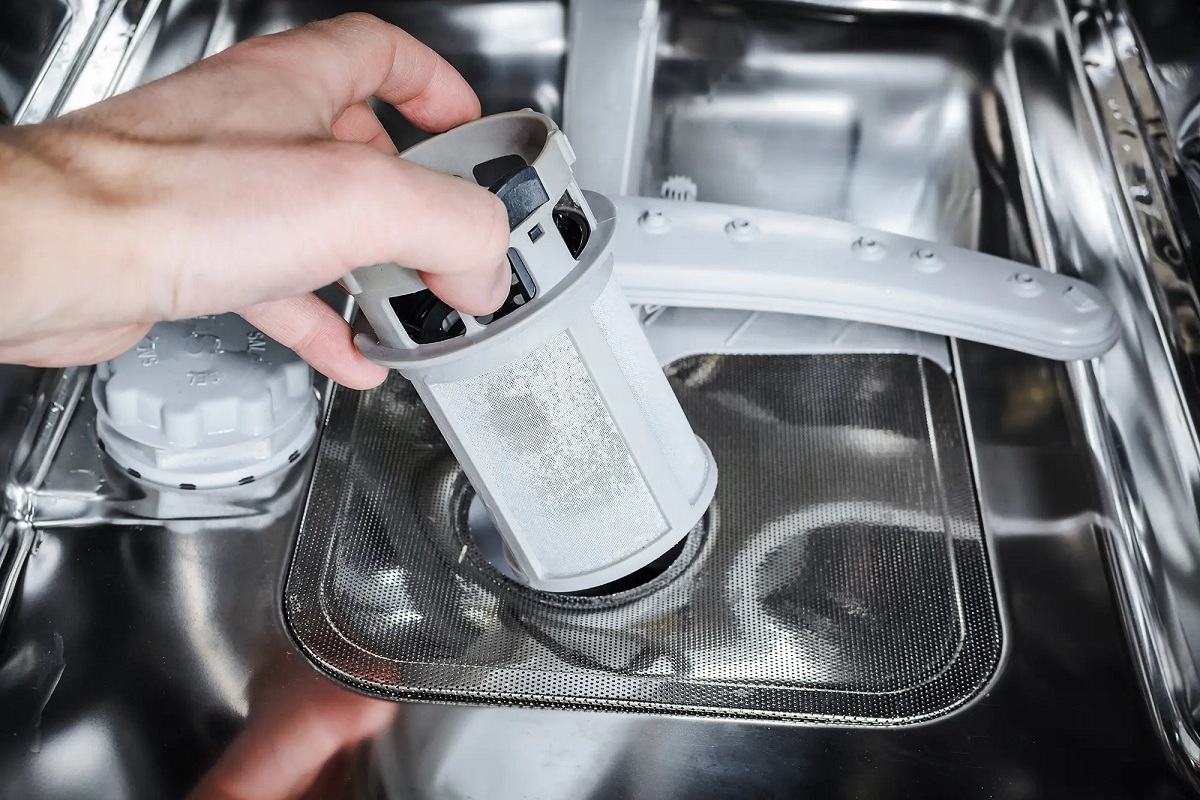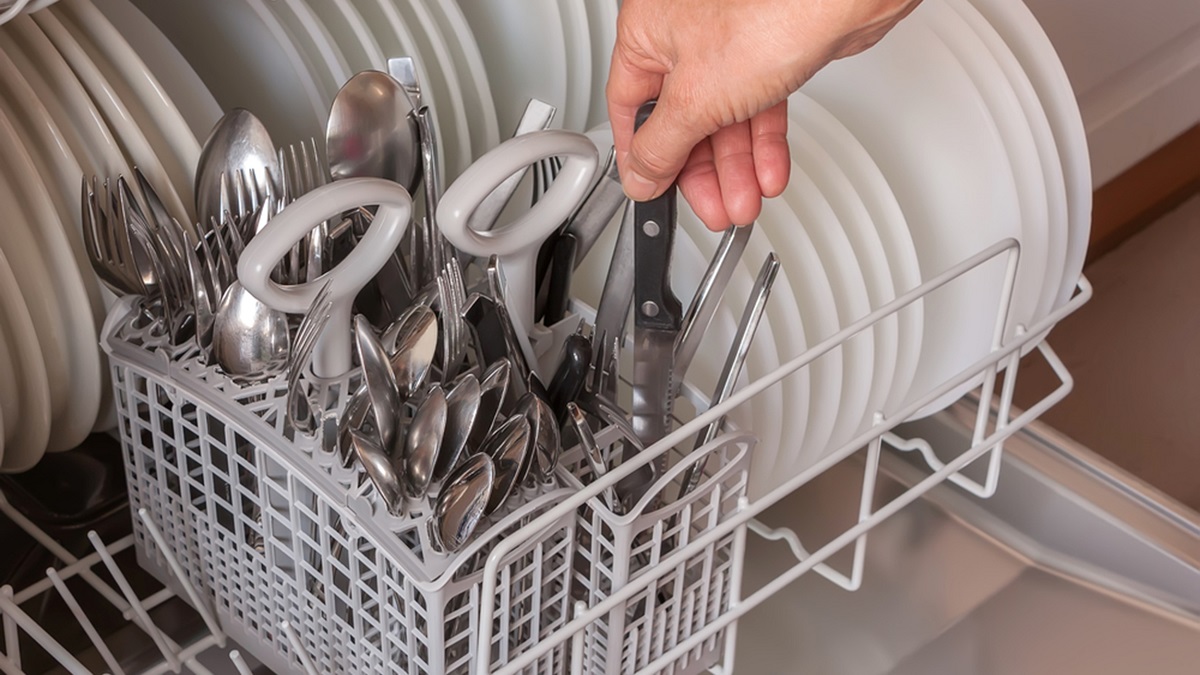Home>Dining>Tableware>Where To Put Stemware In The Dishwasher


Tableware
Where To Put Stemware In The Dishwasher
Modified: January 18, 2024
Looking for the best place to position your tableware in the dishwasher? Discover expert tips on where to put stemware and other tableware for optimal cleaning and protection.
(Many of the links in this article redirect to a specific reviewed product. Your purchase of these products through affiliate links helps to generate commission for Storables.com, at no extra cost. Learn more)
Introduction
Welcome to the world of tableware, where every meal is transformed into an elegant affair. Whether you’re hosting a casual dinner or a grand event, the right stemware can elevate your dining experience to new heights. But with so many options available, it’s crucial to learn how to properly care for and clean your stemware. One key aspect of stemware maintenance is understanding where to place it in the dishwasher.
Dishwashers offer a convenient way to clean a variety of kitchen items, including glassware. However, improper placement of stemware can lead to damage or even breakage. This article will explore the importance of proper stemware placement, provide general guidelines for dishwasher loading, discuss different options for placing stemware in the dishwasher, and offer cleaning and maintenance tips to keep your stemware in pristine condition.
Key Takeaways:
- Proper stemware placement in the dishwasher is crucial for preserving glassware quality, ensuring efficient cleaning, and enhancing the visual appeal of your table setting.
- Consider stemware size, dishwasher configuration, and maintenance tips to choose the best placement option, protecting your stemware and elevating your dining experiences.
Read more: Where To Put Detergent In Dishwasher
Importance of Proper Stemware Placement
Proper stemware placement in the dishwasher is crucial to preserving the quality and longevity of your glassware. Placing stemware in the wrong location can result in damage such as chipping, cracking, or even shattering. Additionally, incorrect placement may cause water spots, residue, or unwanted stains on your stemware, detracting from its visual appeal and diminishing the overall dining experience.
Stemware is delicate and often made from fine materials such as crystal or high-quality glass. These materials are more susceptible to damage from high water pressure or rough handling. By placing your stemware in the appropriate position within the dishwasher, you can minimize the risk of accidental damage and ensure that your glasses remain in pristine condition.
Furthermore, proper stemware placement can help ensure efficient cleaning. Placing your stemware correctly allows for effective water circulation and rinsing, reducing the likelihood of leftover food particles or residue being left behind. By optimizing the cleaning process, you can enjoy sparkling and spotless stemware for every occasion.
Additionally, considering the aesthetics, proper stemware placement can enhance the visual appeal of your table setting. Properly cleaned and undamaged stemware adds an elegant touch to your dining experience, whether it’s a casual dinner with friends or a formal occasion. By paying attention to how you place your stemware in the dishwasher, you can maintain the beauty and sophistication of your tableware collection.
General Guidelines for Dishwasher Loading
Before diving into the specifics of stemware placement, it’s important to understand some general guidelines for loading your dishwasher. Following these guidelines will not only help protect your stemware but also ensure efficient cleaning for all your dishes:
- Pre-rinse your dishes: While modern dishwashers are designed to handle food residue, it’s still a good practice to give your dishes a quick pre-rinse before loading them. This helps prevent food particles from getting stuck to your stemware or other dishes during the wash cycle.
- Separate your dishes: Avoid overcrowding the dishwasher as this can impede water circulation and proper cleaning. Leave enough space between dishes to allow water to reach all surfaces. This will also help prevent stemware from clinking against other items, which can lead to chipping or breakage.
- Load dishes strategically: Place larger and more durable items like plates and bowls at the bottom rack. This allows them to withstand the water pressure from below. Smaller and more delicate items, such as stemware, should be placed on the upper rack.
- Be mindful of utensils: Ensure that utensils are evenly distributed in the utensil basket or caddy to prevent them from nesting together. This ensures efficient cleaning and avoids damage to both the utensils and the stemware.
- Check for dishwasher-safe labels: Not all tableware is dishwasher-safe. Always check the manufacturer’s instructions or label on your stemware to verify if it can be safely cleaned in the dishwasher. If a piece is not dishwasher-safe, it’s best to wash it by hand.
By following these general guidelines, you can set a solid foundation for loading your dishwasher and take the necessary steps to protect your stemware.
Options for Placement of Stemware
When it comes to placing stemware in the dishwasher, you have a few options to choose from. The appropriate option for you will depend on the design of your dishwasher, the size of your stemware, and personal preference. Let’s explore the different options:
- Option 1: Top Rack Placement: Placing stemware on the top rack of the dishwasher is a common practice. This position allows for a milder washing cycle, reducing the risk of damage to delicate glassware. It also keeps them separate from the more rugged items on the bottom rack. Ensure that the glasses are positioned securely, with the stems facing downwards and not touching each other, to prevent them from moving or tipping over during the wash.
- Option 2: Bottom Rack Placement: Some dishwashers offer dedicated stemware holders or slots on the bottom rack for secure placement. This option is suitable for stemware with shorter stems or if the top rack is already occupied. Make sure to place them towards the sides of the rack, away from any other dishes, and ensure that they are stable and won’t come into contact with other items during the wash cycle.
- Option 3: Stemware Holders/Clips: Another option is to use stemware holders or clips designed specifically for dishwashers. These holders attach to the rack and securely hold the stemware in place, reducing the risk of movement and potential damage. Stemware holders are ideal for delicate or oversized stemware that may not fit in the regular dishwasher slots. They provide extra stability and protection during the wash cycle.
Consider the layout and design of your dishwasher, as well as the shape and size of your stemware, when deciding on the best placement option. It’s also worth noting that some dishwashers have specific settings for stemware, which can help optimize the cleaning process and protect your fragile glassware.
Experiment with different placement options to find the one that works best for your stemware collection and dishwasher configuration. Remember, the goal is to find a secure and stable position that allows for thorough cleaning without risking any damage to your precious stemware.
Option 1: Top Rack Placement
Placing your stemware on the top rack of the dishwasher is a popular choice for many households. This option offers several benefits and considerations to ensure the proper cleaning and protection of your fragile glassware.
When placing stemware on the top rack, it’s important to position them securely to prevent movement or tipping over during the wash cycle. Here are some tips for effective top rack placement:
- Stem Positioning: Place your stemware with the stems facing downward. This helps to prevent water from accumulating inside the goblet and ensures effective drainage. Additionally, it reduces the risk of the glasses moving or tipping over during the dishwasher’s agitation cycles.
- Spacing: Ensure that there is enough space between each glass to avoid any contact or clinking during the wash. By providing adequate spacing, you can reduce the risk of chips, cracks, or breakage. If necessary, adjust the position of the glasses or remove an extra item from the load to create enough space.
- Secure Placement: Ensure that the stemware is securely positioned in the slots or tines of the dishwasher rack. It’s essential to prevent the glasses from moving or shifting during the wash cycle. If necessary, you can use adjustable tines or silicone stemware protectors to hold the stems firmly in place.
- Load Balance: Distribute the weight of the stemware evenly across the rack to maintain balance and stability. Avoid loading too many glasses on one side, as this can cause the rack to tilt and potentially result in the glasses falling or colliding with other items.
By following these tips, you can ensure that your stemware is in an optimal position for cleaning on the top rack of your dishwasher. Remember to consult your dishwasher’s user manual for any additional recommendations or guidelines specific to your appliance model.
Ultimately, top rack placement offers a mild washing cycle for your stemware, reducing the risk of damage while still providing effective cleaning. It keeps your delicate glassware separated from the more rugged items placed on the bottom rack, minimizing the chance of chips or breakage.
However, it’s important to note that not all stemware is dishwasher-safe. Check the manufacturer’s instructions or label to verify if your glasses are suitable for dishwasher use. If your stemware is particularly delicate or valuable, you may choose to hand wash it instead to ensure its longevity and pristine condition.
Place stemware on the top rack of the dishwasher to prevent breakage and ensure a gentle wash. Use stemware holders or secure glasses between the tines to keep them stable during the cycle.
Read more: Where To Put Pod In Dishwasher
Option 2: Bottom Rack Placement
In certain dishwashers, there are designated slots or holders on the bottom rack specifically designed for stemware placement. This option is ideal if your stemware has shorter stems or if the top rack is already occupied with other dishes. Here are some considerations for safely placing your stemware on the bottom rack:
- Stable Placement: Ensure that the stemware sits securely in the designated slots or holders. This helps to prevent movement and minimize the risk of contact with other dishes or the dishwasher’s agitator. Check that the glasses are stable and won’t tip over during the wash cycle.
- Proper Positioning: Place the stemware towards the sides of the rack to keep them separate from other items. This reduces the chances of collision and potential damage. Additionally, position the glasses so that they angle slightly, with the rims facing downward. This promotes efficient drainage and prevents water from collecting inside the goblets.
- Spacing: Provide adequate spacing between each glass to avoid any contact or clinking during the wash. This prevents chips, cracks, or breakage. If necessary, adjust the position of the stemware or rearrange other items on the rack to create enough space.
- Load Balance: Distribute the weight of the stemware evenly across the bottom rack to maintain stability. Avoid overloading one side of the rack, as this can cause imbalance and potential tipping of the glasses. Ensure that the stemware is balanced with other dishes to prevent any toppling during the wash cycle.
When opting for bottom rack placement, it’s essential to be mindful of the size and design of your stemware. Some stemware with longer or fragile stems may not fit securely or may be prone to damage on the bottom rack. Additionally, verify whether your stemware is dishwasher-safe before placing it on the bottom rack.
Bottom rack placement is a suitable option if your dishwasher has specific stemware holders or slots. It allows for effective cleaning while ensuring your stemware is separate from other items on the rack. Just be cautious and verify that your stemware is compatible with this placement option to avoid any potential damage or breakage.
If you are unsure about using the bottom rack for your stemware, it’s always a safe choice to consult the manufacturer’s instructions or follow their recommended dishwasher loading guidelines.
Option 3: Stemware Holders/Clips
If you want to provide extra protection and stability to your stemware during the dishwasher cycle, using stemware holders or clips can be a great option. These specially designed accessories attach to the dishwasher rack and securely hold the stems of your glasses. Here are some key considerations for using stemware holders or clips:
- Select the right holders/clips: Choose stemware holders or clips that are compatible with your dishwasher model and the size of your stemware. Different manufacturers offer various styles and designs to accommodate different stemware shapes and sizes. Ensure that the holders or clips are made from materials that won’t damage or scratch your stemware.
- Attach the holders/clips securely: Properly attach the stemware holders or clips to the dishwasher rack, following the manufacturer’s instructions. Make sure they are firmly in place to prevent any movement or dislodging during the wash cycle.
- Place the stemware in the holders/clips: Gently insert the stems of your glasses into the holders or clips, ensuring a secure fit. The holders or clips should grip the stems without being too tight or loose. Check that the glasses are stable and won’t tip over or collide with other items in the dishwasher.
- Positioning and spacing: Arrange the stemware holders or clips in a way that provides adequate spacing between the glasses to avoid contact or clinking during the wash cycle. This helps prevent chips, cracks, or breakage. Ensure that the holders or clips are positioned in a balanced manner on the dishwasher rack.
- Load balance: Distribute the weight of the stemware holders or clips evenly across the dishwasher rack to maintain stability. Avoid overloading one side of the rack, as this can lead to imbalance and potentially cause the stemware to tip over. Create a balanced load with other dishes to prevent any accidents during the wash cycle.
By utilizing stemware holders or clips, you can provide an extra layer of protection for your delicate stemware. These accessories help keep the glasses secure, preventing movement and potential damage. Stemware holders or clips offer peace of mind, especially for valuable or fragile stemware pieces that require additional care during the dishwasher cycle.
Remember to choose stemware holders or clips that are specifically designed for dishwasher use and suitable for your stemware collection. Follow the manufacturer’s instructions and guidelines for proper installation and usage to ensure the best results.
Using stemware holders or clips can be a reliable option, particularly if your stemware doesn’t fit securely in the dishwasher slots or if you want to take extra precautions to protect your cherished glasses. It’s an investment that can help prolong the lifespan of your stemware and ensure its continued beauty for many enjoyable dining experiences.
Factors to Consider when Choosing Stemware Placement
When deciding where to place your stemware in the dishwasher, several factors should be considered to ensure optimal cleaning and protection. Taking these factors into account will help you choose the most suitable placement option for your specific stemware collection. Here are some important factors to consider:
- Stemware Size and Shape: The size and shape of your stemware play a significant role in determining the placement option. Tall and slim glasses may be better suited for top rack placement, while shorter glasses may fit well in designated slots on the bottom rack. Consider the dimensions of your stemware to ensure a secure fit and protect against potential damage.
- Stem Length: The length of the stems on your stemware can impact the placement choice. Glasses with longer stems may be more prone to tipping over or coming into contact with other items during the wash cycle. If your stemware has longer stems, it may be safer to place them on the top rack or use stemware holders or clips for added stability.
- Stability: Ensuring that your stemware stays stable and secure during the dishwasher cycle is crucial. Glasses that are prone to tipping or moving may be at higher risk of damage. Evaluate the stability of your stemware and select a placement option that minimizes the chance of any movement or collisions with other items in the dishwasher.
- Dishwasher Configuration: Consider the design and layout of your dishwasher, as it can impact your stemware placement options. Some dishwashers have adjustable racks or specific features for stemware, such as dedicated slots or stemware holders. Familiarize yourself with your dishwasher’s capabilities and utilize any specialized features it offers for stemware placement.
- Dishwasher Settings: Depending on your dishwasher model, there may be different settings or modes specifically designed for stemware cleaning. These settings typically offer gentler cycles with reduced water pressure to protect delicate glassware. Familiarize yourself with the available settings and utilize them when washing your stemware.
- Dishwasher-Safe Labels: Not all stemware is dishwasher-safe, so it’s important to check the manufacturer’s instructions or label on your glasses. Some stemware may require hand washing to maintain their quality and prevent damage. If your glasses are not labeled as dishwasher-safe, it’s best to err on the side of caution and wash them by hand.
By considering these factors, you can make an informed decision on how to place your stemware in the dishwasher. Remember, the ultimate goal is to find a placement option that ensures both effective cleaning and the protection of your valuable stemware.
Every stemware collection is unique, and what works for one may not work for another. Take the time to evaluate your stemware, understand your dishwasher’s capabilities, and choose the placement option that best suits your specific requirements. With the right placement, you can maintain the beauty and functionality of your stemware for years to come, enhancing your dining experiences with each use.
Cleaning and Maintenance Tips for Stemware in the Dishwasher
Maintaining the cleanliness and longevity of your stemware requires proper care and maintenance, especially when using the dishwasher. Here are some essential tips to ensure that your stemware remains in pristine condition:
- Read the manufacturer’s instructions: Start by reading the manufacturer’s instructions or recommendations for cleaning your stemware in the dishwasher. Different glasses may have specific care instructions that you should follow to avoid any potential damage.
- Load stemware with care: Handle your stemware carefully when loading it into the dishwasher. Avoid hitting or bumping the glasses against other items, as this can lead to chipping or breakage. Place them gently and ensure a secure fit in the designated slots or holders.
- Separate stemware from other items: To minimize the risk of damage, keep your stemware separate from other dishes and utensils in the dishwasher. This prevents them from clinking together or being scratched by hard objects.
- Use a gentle wash cycle: Opt for a gentle or delicate wash cycle when cleaning your stemware. These cycles typically have lower water pressure and are designed to be more suitable for fragile glassware. Avoid using intense or heavy-duty cycles, as they can increase the risk of damage.
- Ensure proper spacing: Allow enough space between each glass to prevent any contact or collision during the wash cycle. Proper spacing minimizes the risk of chips or breakage and allows for effective cleaning of your stemware.
- Unload stemware carefully: Once the dishwasher cycle is complete, carefully remove your stemware from the dishwasher. Hold the glasses by the base or stem to avoid putting pressure on the delicate rims. Place them on a soft, clean towel or drying rack to air dry.
- Inspect for spots or residue: After the stemware has dried, inspect it for any spots or residue. If you notice any, you may need to hand wash or use a soft cloth to remove stubborn stains or water spots. Avoid using abrasive sponges or harsh cleaning agents that can damage the glass.
- Regularly inspect for damage: Regularly inspect your stemware for any signs of damage, such as chips, cracks, or loose stems. If you notice any issues, it’s best to stop using those glasses in the dishwasher and hand wash them instead to prevent further damage.
Additionally, it’s worth noting that not all stemware is dishwasher-safe. Some materials, such as fine crystal or antique glasses, may require hand washing to preserve their quality and prevent potential damage. Always check the manufacturer’s instructions or label on your stemware to determine the recommended cleaning method.
By following these cleaning and maintenance tips, you can confidently use your dishwasher to keep your stemware clean and in excellent condition. Proper care not only protects your investment but also ensures that your stemware continues to enhance your dining experiences for years to come.
Read more: Where To Put Rinse Aid In Dishwasher
Conclusion
Proper stemware placement in the dishwasher is essential for maintaining the beauty and longevity of your glassware. By understanding the importance of correct stemware placement, following general guidelines for dishwasher loading, and considering various options such as top rack placement, bottom rack placement, or the use of stemware holders or clips, you can protect your stemware from damage and ensure effective cleaning.
It’s crucial to consider factors such as stemware size and shape, stem length, stability, dishwasher configuration, and dishwasher settings when choosing the appropriate placement option. Taking these factors into account will help you determine the safest and most effective way to clean your stemware in the dishwasher.
Remember to always read the manufacturer’s instructions for your stemware and dishwasher and check the dishwasher-safe labels on your glasses. Some stemware may require hand washing to preserve their quality and prevent damage.
Additionally, proper care and maintenance are key to keeping your stemware in pristine condition. Load your stemware with care, separate it from other items, use a gentle wash cycle, ensure proper spacing, and unload it carefully. Regularly inspect your stemware for any signs of damage and address any issues promptly.
By following these guidelines and taking the necessary precautions, you can confidently use your dishwasher to clean your stemware, creating an elegant and efficient washing routine that preserves the beauty and functionality of your precious glassware.
So, next time you set the table and invite your guests to a delightful dining experience, rest assured knowing that your stemware is in safe hands and ready to shine.
Frequently Asked Questions about Where To Put Stemware In The Dishwasher
Was this page helpful?
At Storables.com, we guarantee accurate and reliable information. Our content, validated by Expert Board Contributors, is crafted following stringent Editorial Policies. We're committed to providing you with well-researched, expert-backed insights for all your informational needs.














0 thoughts on “Where To Put Stemware In The Dishwasher”